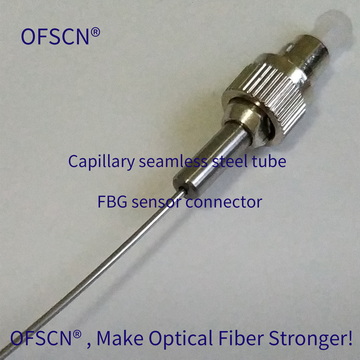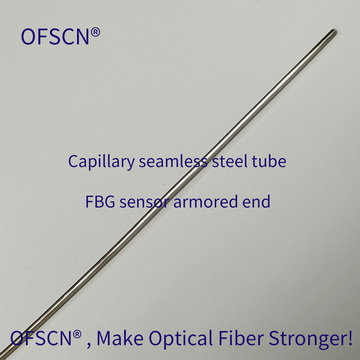This article introduces the working temperature range of the OFSCN® 300°C Capillary Seamless Steel Tube Fiber Bragg Grating (FBG) temperature sensor (FBG thermometer), including its maximum high-temperature endurance and maximum low-temperature values. It also describes the methods and principles for determining the working temperature range of fiber Bragg grating temperature sensors (including the stainless steel materials used and the femtosecond fiber bragg grating).
The working temperature range of fiber bragg grating sensors is primarily determined by the fiber bragg grating and the sensor packaging materials. Therefore, analysis needs to be conducted from these two aspects.
1. Working Temperature Range of Packaging Material for OFSCN® 300-degree Celsius Capillary Seamless Steel Tube Fiber Bragg Grating Temperature Sensor (FBG Thermometer)
The OFSCN® 300°C Capillary Seamless Steel Tube Fiber Bragg Grating (FBG) temperature sensor developed by DCYS adopts a unique patented technology for stainless steel seamless tube packaging. Its structure is extremely simple, with no adhesive or other auxiliary materials. It is composed of only fiber bragg gratings (FBGs) and stainless steel seamless tubes. Therefore, determining its operating range only requires analyzing the fiber bragg gratings (FBGs) and stainless steel materials.
 |
 |
|
Figure 1 |
Figure 2 |
For the OFSCN® 300°C Capillary Seamless Steel Tube Fiber Bragg Grating (FBG) temperature sensor, its low-temperature working temperature range at the measurement point is -200°C, its long-term working temperature range in the high-temperature region is up to +300°C, and its short-term working temperature range in the high-temperature region is up to +350°C. In actual measurements, the sensor has been used at temperatures up to +600°C for short durations.
The temperature of these two high -temperature ranges doesn’t not reach the temperature limit of stainless steel materials, nor does it reach the limit of FBG’s coating material- polyimide. This temperature range is mainly limited by the ultraviolet lighting template production methods of FBG.
2. Working Temperature Range of FBG for OFSCN® 300-degree Celsius Capillary Seamless Steel Tube FBG Temperature Sensor (FBG Thermometer)
 |
|
Figure 3 |
 |
| Figure 4 |
The fiber bragg grating (FBG) produced using the ultraviolet (UV) writing mask production method may experience degradation when exposed to a temperature environment of 400°C for an extended period. This degradation is reflected in the FBG sensor as a gradual decrease in the reflection rate of the fiber bragg grating during use.
To ensure safety and reliability, DCYS has determined the working temperature range for the FBG sensor. The low-temperature region operates within -200°C, while the long-term working temperature range in the high-temperature region is up to +300°C. Additionally, the FBG sensor can withstand short-term use at temperatures up to +350°C, meaning it can be repeatedly used in environments up to +350°C (continuous use in a 300°C environment). It's important to note that the high-temperature range is based on actual measured values, while the low-temperature range is based on theoretical values.
 |
| Figure 5 |
Our philosophy is: "OFSCN®, make optical fiber stronger!"
